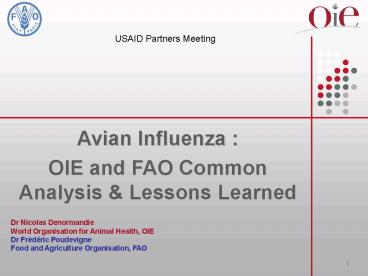Avian Influenza : - PowerPoint PPT Presentation
1 / 14
Title:
Avian Influenza :
Description:
Difficult to control in countries if unable to rapidly detect and control the virus ... threat of transboundary spread (reintroducing threat) from enzootic country ... – PowerPoint PPT presentation
Number of Views:25
Avg rating:3.0/5.0
Title: Avian Influenza :
1
USAID Partners Meeting
Avian Influenza OIE and FAO Common Analysis
Lessons Learned
Dr Nicolas Denormandie World Organisation for
Animal Health, OIE Dr Frédéric Poudevigne Food
and Agriculture Organisation, FAO
2
(No Transcript)
3
HPAI endemic Countries
4
Research of H5N1 on Wild birds (FAO-CIRAD Survey)
- 2006 n gt5 000
- viral Detection
- no H5N1 detected
- no HPAI (clinic)
- LPAI detection 3,3
- Campagne 2007 n gt5 000
- viral Detection(n8000)
- So far no H5N1 detected
- no other HPAI strain, so far
- LPAI detection 0,4
Sites de prélèvements en 2006
5
The Current H5N1 Asian strain
- Spread through 3 continents
- Role of migratory waterfowl ?
- Role of commercial exchanges
- Difficult to control in countries if unable to
rapidly detect and control the virus - The widespread over 3 continents is a first time
- 60 countries infected since end of 2003
- Stability of the strain no human to human
transmission - REMINDER H5N1 can be low pathogenic (8 genes
are involved)
6
Important Lessons learned
Global
- Poultry sector a revolution
- Added Value from Regional approach and
cooperation between countries - Learn from others experience
- Harmonize methodologies, strategies
- Share information
- Coordination among partners real progress
7
Important Lessons learned
From prevention and surveillance
- Early detection and rapid response has prevented
establishment of disease in the majority of the
infected countries . - Reliable data on poultry sector and value chain
(for cost effective measures) - Delayed detection and response has led to endemic
or uncontrolled situation (Indonesia, Nigeria,
Egypt) - Laboratory efficiency is crucial.
- The role of public and private veterinary
networks is important as well as all actors (CDS) - Authoritarian policies to change poultry
production systems are often inefficient and can
be risky
8
Important Lessons learned (Cont)
From Outbreak control
- Strong governance and efficient national chain of
command are essential - Importance of security forces to secure
restricted areas - Culling is an expensive control measure but so
far most effective - Compensation is crucial to encourage transparency
and biosecurity measures () - Technical support assistance
- Integrated control programs are more successful
(communication, socio economic, animal and public
health) - Each country should develop the strategy based on
their own situation - Vaccination can limit spread but used alone and
without permanent monitoring it does not
eliminate H5N1 - Importance of continued donor support
9
Important Lessons learned (Cont)
From Pandemic preparedness activities
- The competition in resources between animal
disease control and pandemic preparedness
complicates the implementation of efficient
control strategies - All governments followed WHO recommendations even
if not relevant to their national situation. - No proven human transmission from the
consumption of poultry products - Importance of good quality and more specific
communication
10
Important Lessons learned (Cont)
From Regional survey
- Trade (legal or illegal) plays a major part in
spreading the disease - Increasing awareness in cross border issues
- Continuing threat of transboundary spread
(reintroducing threat) from enzootic country - HPAI infections may have become established in
wild water bird populations (re-infections)
11
Positive Trends
- Mortality of wild birds is currently strongly
decreasing - Countries are able to detect and resolve
outbreaks quicker - Less outbreaks in domestic poultry in most newly
infected countries - Species other than wild birds and poultry have
not yet been involved in the transboundary spread
of the virus - Availability of international funds
12
Positive Trends
- Capacity building in veterinary services
- Improvement of laboratory infrastructures and
capacity - Better sharing of strains and data
- No human cases without animal outbreaks present
13
Pandemic Potential
- No human cases without animal outbreaks present
- All countries worldwide should be able to detect
early and control the virus quickly at its animal
source - Improvements and investments in Veterinary
Services to address this concern are also
relevant for responding to future emerging and
re-emerging diseases linked with globalization
and climatic changes
14
THANK YOU FOR YOUR ATTENTION!

